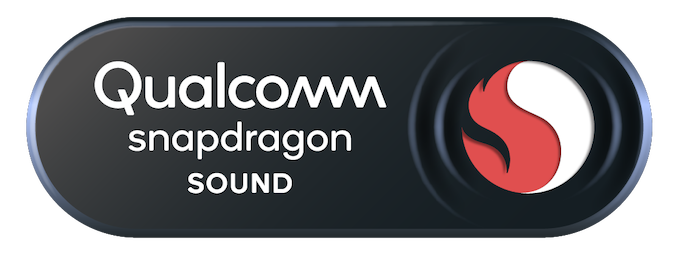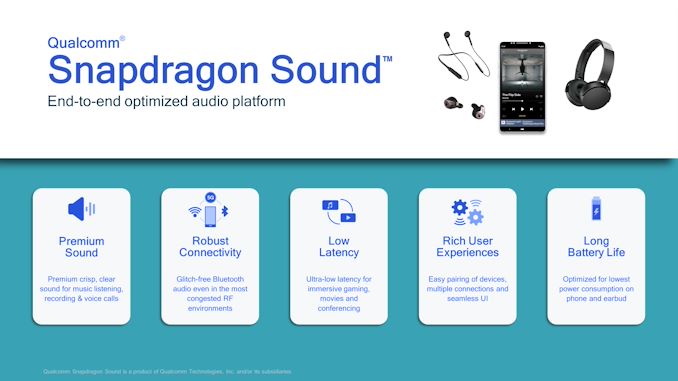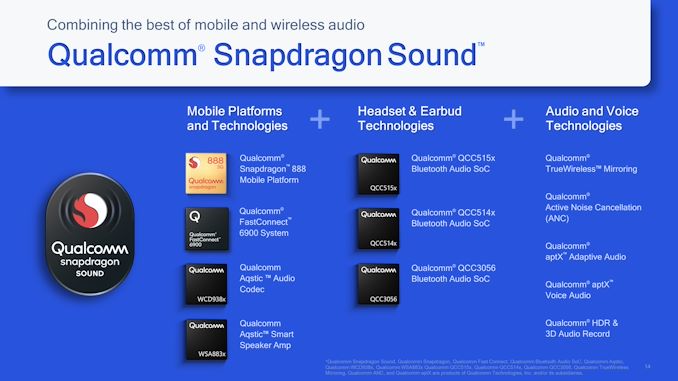Qualcomm Announces "Snapdragon Sound" Initiative
by Andrei Frumusanu on March 4, 2021 11:00 AM EST- Posted in
- Mobile
- Audio
- Qualcomm
- Smartphones

Today Qualcomm is announcing the new “Snapdragon Sound” branding initiative, essentially an umbrella term that covers the company’s various audio related hardware and software products, promising improved end-to-end interoperability for a better audio experience.
Qualcomm’s initiative is rather vague, but it appears to be to be focused on a certification program that ensures correctly engineered software stacks between a phone’s audio subsystem and the listening device. Qualcomm here particularly looks to focus on wireless audio technologies with greater audio fidelity, most of the technologies surrounding Qualcomm’s proprietary aptX codec and its derivatives. At least one concrete example of an optimised Snapdragon Sound system is Bluetooth audio latency, which would reach down to 89ms in the company’s example.
On the hardware side of things, mobile platforms obviously cover Qualcomm’s Aqstic audio codec chips as well as speaker amplifiers, but extends the umbrella out to the company’s Bluetooth audio SoCs which are popular amongst wireless headphone manufacturers.
It’s not clear if the end-to-end optimisations are solely limited to Qualcomm hardware products, or if third-party audio hardware solutions will also gain benefit of the optimised audio stack.
Qualcomm states that the first devices supporting Snapdragon Sound optimisations are expected to be available later this year.












41 Comments
View All Comments
mode_13h - Sunday, March 7, 2021 - link
But the clicking issue was worst on my previous phone: Nexus 5X. I thought the newer phone didn't have the issue, but then noticed it a little, so I wonder if it's some kind of Android thing?Anyway, by that point, I was using bluetooth headphones with phone nearly all the time, so I didn't invest any time or effort to investigate or remedy the issue.
Hideo - Wednesday, March 17, 2021 - link
I can only have a great thing to say about S10e in this regard. Superb Audio Out on headphones is one of the reasons why I am reluctant to change for newer mobile. I am especially impressed how well it powers HD650 which usually needs headphone amp for good results. If possible, I can't recommend enough.damianrobertjones - Thursday, March 4, 2021 - link
How about plugging in a lovely USB Rode microphone and having it as the one and ONLY input source for anything that records? Or, even, have it as an option. or both, to record two mics at the same time??ikjadoon - Thursday, March 4, 2021 - link
>Bluetooth audio latency, which would reach down to 89ms in the company’s example.And that’s good? Damn, how bad is bad Bluetooth latency? SBC looks like 200ms+ 😅
One day, the world will vocally hate Bluetooth audio as much as we hate USB type-C. A myriad of codecs (aptX, SBC, AAC, etc.), nobody knows what’s compatible with what on which firmware version on which device, and the default is still a terrible old legacy format that at least works everywhere. We’re about 6 versions deep into Bluetooth and hardly a handful of people in the world can tell you the differences between Bluetooth 4.1 vs Bluetooth 5.2 vs Bluetooth 5.1 va Bluetooth 4.2 vs Bluetooth 4.
75ms is usually the upper-end of what RTINGS considers acceptable for audio-video sync. It doesn’t look like an RF limitation; niche (great, more “standards”) Bluetooth codecs have brought it down to 30ms.
https://www.rtings.com/soundbar/tests/connectivity...
Surprises Qualcomm is bragging about their own codec still 1/10th of a second off. What else do we expect from a modem company?
mode_13h - Friday, March 5, 2021 - link
Don't forget about Sony's LDAC and HWA's LDHC!ZolaIII - Friday, March 5, 2021 - link
Those become open source at least.mode_13h - Saturday, March 6, 2021 - link
Sony took the approach of making free & easy for phones and other sources to support their headphones, but you still owe them a licensing fee if you want to build a headphone or wireless speaker that supports LDAC.mode_13h - Saturday, March 6, 2021 - link
In other words, it's free & easy to make products that interoperate with theirs, but not ones which compete with them.mode_13h - Friday, March 5, 2021 - link
Also, aptX comes in several flavors (HD, LL, Adaptive, others)Silver5urfer - Thursday, March 4, 2021 - link
Nothing that a 3.5mm can do, which is older than 150 years.This garbage cannot even make the bitrate higher than LDAC at 900Kbps which consumes battery fast. The AptXHD maxes at 500ish, for basic 320 we have AptX, and more royalty certification bullcrap for Qualcomm. More use and throw garbage products, every year you can buy them at $100-250, Apple pumped new $550 trash which doesn't even have AptX class audio quality. But hey it's Apple and H1 chip and etc bs. While a 3.5mm jack can process FLAC and DTS formats more than 1600Kbps to 5000Kbps data rate with zero performance impact or battery, or any Interference. Even in Mobiles, from low quality garbage to high end audio in LG phones.
A headphone jack from LG phones have Impulse response filters, sound turning options, not even just playback but even Hi Fi recording in 24Bit FLAC at 192KHz and filters to proof from low bass frequencies, wind noise filters plus an SD card too. But who cares ? Mass market, lowest possible denominator is what that matters.
Absolute junk is what that matters, which is why Beats audio and Bose generate so much money almost literally half of the Audio market in Mainstream consumer market. Esp in Wireless Apple pocketed 1/2 Dollar in 2016, now it might be 80% of a Dollar spent.